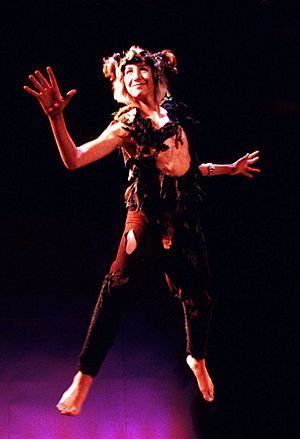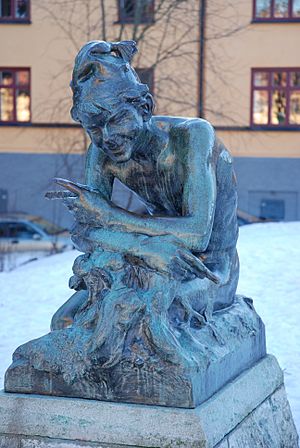Puck (A Midsummer Night's Dream) facts for kids
Puck, also known as Robin Goodfellow, is a famous character from William Shakespeare's play, A Midsummer Night's Dream. He is a playful and mischievous fairy or sprite. Puck loves to play tricks on people, like when he changes a character's head into that of a donkey! He is one of the most important fairy characters and causes many of the funny mix-ups in the story.
Puck is based on old English and Celtic stories about similar magical beings. He is often seen as a jester or trickster.
Contents
Puck's Role in the Play

Puck first appears in the play's second act. Another fairy asks him if he is Robin Goodfellow, the mischievous sprite who plays tricks on villagers. Puck proudly confirms that he is indeed that "merry wanderer of the night." He describes some of his favorite pranks:
- He tricks horses by neighing like a young foal.
- He hides in a drink, then bobs up to spill it on someone.
- He makes old women fall off their stools by pretending to be the stool.
Puck works for Oberon, the king of the fairies. Oberon is upset with Titania, the fairy queen. She won't give him a special "little changeling boy" (a human child she adopted).
Oberon sends Puck to find a magical flower. The juice from this flower, when put on someone's eyelids while they sleep, makes them fall madly in love with the first creature they see when they wake up. Oberon wants Puck to use this juice on a young man named Demetrius, who is being unkind to a woman named Helena.
However, Puck makes a mistake! He puts the juice on Lysander instead of Demetrius. This causes a lot of confusion and funny situations among the young lovers.
Oberon also puts some of the flower's juice on Titania's eyes. When she wakes up, she sees Nick Bottom, an actor whose head Puck has magically changed into that of a donkey! Titania falls deeply in love with the donkey-headed Bottom.
Later, Puck is ordered to fix his mistakes with Lysander and Demetrius. He creates a thick, black fog to separate the arguing young men. He imitates their voices until they fall asleep.
Puck speaks the very last lines of the play. He asks the audience to imagine that if they were offended by the play, they should just think it was all a dream. He promises that the actors will do better if the audience forgives them.
Puck's Name in the Play
In Shakespeare's time, plays didn't always have clear lists of characters. Also, the names used for characters could change. For Puck, the original texts sometimes call him "Robin Goodfellow" and sometimes "Puck." This happens even within the same scene! Modern versions of the play usually call him "Puck" and change any stage directions that use "Robin" or "Robin Goodfellow."
Puck in Movies and TV
Puck has been played by many actors in films and TV shows:
- Mickey Rooney played him in the 1935 film A Midsummer Night's Dream.
- Ian Holm was Puck in the 1968 film version.
- Phil Daniels played Puck in a 1981 BBC TV show.
- Robert Sean Leonard played Puck in a school play shown in the 1989 film Dead Poets Society.
- Brent Spiner voiced a version of Puck in Disney's Gargoyles cartoon in 1995.
- Stanley Tucci played Puck in the 1999 film.
- Tanner Cohen was Puck in a school play in the 2008 film Were the World Mine.
- Hiran Abeysekera played Puck in the 2016 film.
- Avan Jogia was Puck in the 2017 film.
- Ken Nwosu played Puck in the TV show Upstart Crow in 2018.
- Jonathan Whitesell played a version of Robin Goodfellow in The Chilling Adventures of Sabrina in 2020.
Puck in Video Games
- In the video game God of War Ragnarök, the character Mimir is revealed to be Puck. Mimir was once a fairy king's helper and jester. He traveled north and became an advisor to Odin. Later, he was imprisoned in a tree until Kratos and his son freed him. Mimir shares many stories about Norse Mythology with the players.
Puck in Theatre
Many actors have played Puck on stage:
- Frederick Peisley in 1947.
- Adam Darius in Sweden in 1961.
- John Kane with The Royal Shakespeare Company in 1970.
- In the 1999 musical The Donkey Show, Puck is renamed "Dr. Wheelgood."
- Matthew Tennyson at Shakespeare's Globe Theatre in 2013.
- Kathryn Hunter in a 2013 production by Julie Taymor.
Puck in School Plays
Even famous actors played Puck when they were in school:
- Laurence Olivier played Puck at St Edward's School, Oxford, in 1923.
- Sebastian de Souza also played Puck at St Edward's School, Oxford.
Puck in Art and Music
Puck has inspired many artists and musicians:
- Puck (1789) is a famous painting by Joshua Reynolds.
- Puck (c. 1810–1820) is another painting by Henry Fuseli.
- Puck (c. 1855–1856) is a marble sculpture by Harriet Hosmer.
- The Puck Building in New York City, built in 1885–1888, has two statues of Puck by Henry Baerer. The building was named after a 19th-century humor magazine called Puck, which also used the character as its symbol.
- A bronze sculpture called Puck by Carl Andersson was made in 1912 in Stockholm, Sweden.
- Puck by Brenda Putnam is a marble sculpture from 1932 at the Folger Shakespeare Library in Washington, D.C.
- French composer Claude Debussy wrote a piano piece called La danse de Puck (Puck's Dance).
Puck in Literature
- In Neil Gaiman's comic book series The Sandman, Puck appears in a story called "A Midsummer Night's Dream" (1990). In this story, Puck and other fairies watch Shakespeare's actors perform the play. After the show, Puck decides to stay in the human world and appears in later stories in the series.
See also
 In Spanish: Puck (Shakespeare) para niños
In Spanish: Puck (Shakespeare) para niños



